Costa Concordia
Specifications of Costa Concordia
| Year of build | 2006 / Age: 11 |
| Builder | Fincantieri (Sestri Ponente, Genoa Italy) |
| Class | Costa CONCORDIA |
| Building cost | EUR 450 million (USD 570 million / GBP 372 million) |
| Engines (power) | Wartsila (42 MW / 56323 hp) |
| Speed | 23 kn / 43 km/h / 26 mph |
| Length (LOA) | 290 m / 951 ft |
| Beam (width) | 36 m / 118 ft |
| Gross Tonnage | 114147 gt |
| Passengers | 3002 - 3765 |
| Crew | 1100 |
| Passengers-to-space ratio | 31 |
| Decks | 13 |
| Cabins | 1501 |
| Decks with cabins | 8 |
| Last Refurbishment | Genoa-scrapped in 2017 |
| Sister-ships | Costa Serena, Costa Pacifica, Costa Favolosa, Costa Fascinosa, Carnival Splendor |
| Christened by | Eva Herzigova |
| Owner | Carnival Corporation & PLC |
| Operator | Costa Cruises |
Costa Concordia Review
Review of Costa Concordia
The 2006-built cruise ship Costa Concordia was a Carnival Corporation-owned Concordia-Class passenger liner identified by IMO number 9320544, MMSI number 9320544 (Italy-flagged), and Call Sign IBHD.
The vessel was designed and constructed in Italy by one of the world's largest shipbuilding companies—Fincantieri—at its Sestri Ponente Shipyard (near Genoa).
The ship was operated by Costa Cruises (a Carnival Corporation subsidiary and its second-largest brand by fleet size and annual passenger volume).
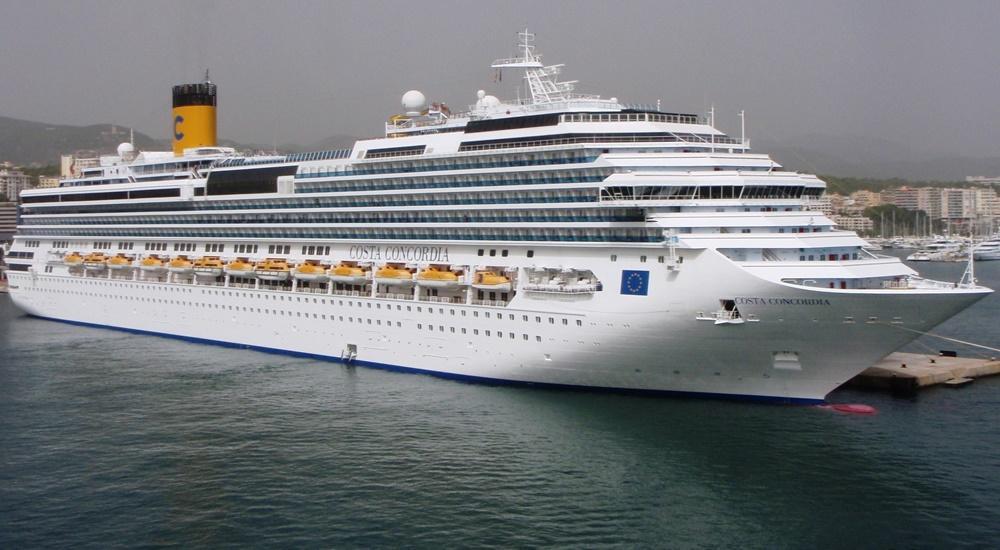
Concordia was the first of five Concordia-class ships operated by Costa Crociere, along with sisterships Serena (2007), Pacifica (2009), Favolosa (2011), and Fascinosa (2012), plus Carnival Cruise Line's Carnival Splendor (2008).
This large (115,000 GT) and elegantly designed vessel was wrecked off Giglio Island (Italy) on January 13, 2012, due to human error that caused an allision with an underwater rock. Hours later, the ship capsized and was later declared a total loss. In July 2014, the wreck was towed to Genoa for dismantling.
The vessel’s 3.5-year salvage effort became the most expensive and complex maritime recovery operation ever conducted.
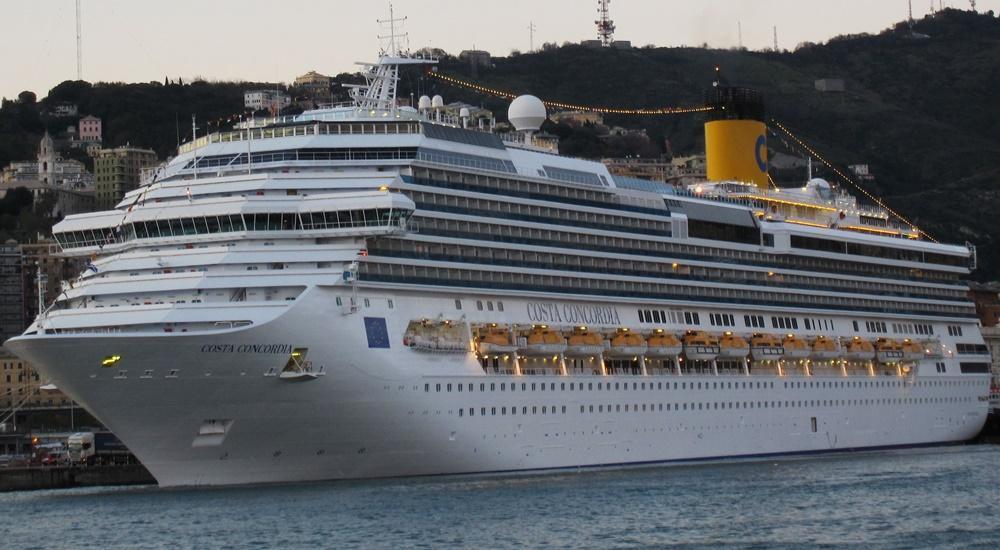
This page primarily reviews the salvage operation and the disaster's impact on the shipowner and cruise industry. It includes comparisons and detailed explanations of the vessel’s removal plan and procedures. For the full report, see the CruiseMinus accident report. You can also jump to specific sections: salvage plan, removal operation and procedures, wreckage removal progress, Captain's wiki.
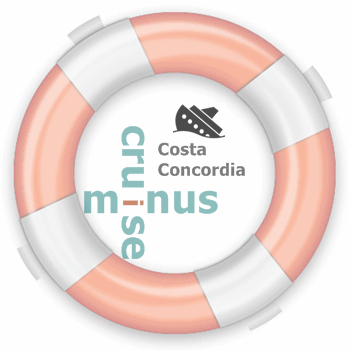
After reading these details, you’ll understand why Costa Concordia’s sinking was called the most "stupidly unique" cruise ship disaster. It happened on Friday, January 13, 2012—off Tuscany’s west coast, near Giglio Island. The tragedy resulted in loss of life and massive financial damages, becoming a major catalyst for reviewing cruise ship safety standards.
Costa Concordia Salvage
Fuel-pumping preparations began on January 26, 2012. Workers from Dutch salvage company SMIT International used a craned barge and began underwater inspections to locate the vessel’s 17 fuel tanks—containing nearly 2 million liters of heavy diesel. The first six tanks (over 50% of the fuel) were prioritized. The operation took four weeks and involved drilling into the tanks, attaching valves, heating the sludge-like oil, and vacuuming it out while displacing it with seawater.
Fuel extraction started on February 11, 2012, and was completed on March 25, 2012. The ship’s location offered some protection from rough seas, as it lay on the coastal side of Giglio Island.
On February 3, 2013, Costa announced that the wreck would be refloated and removed whole, not dismantled onsite. The CEO, Pier Luigi Foschi, stated the wreck was “no longer usable.” The removal effort set a world record as the largest ever maritime salvage.
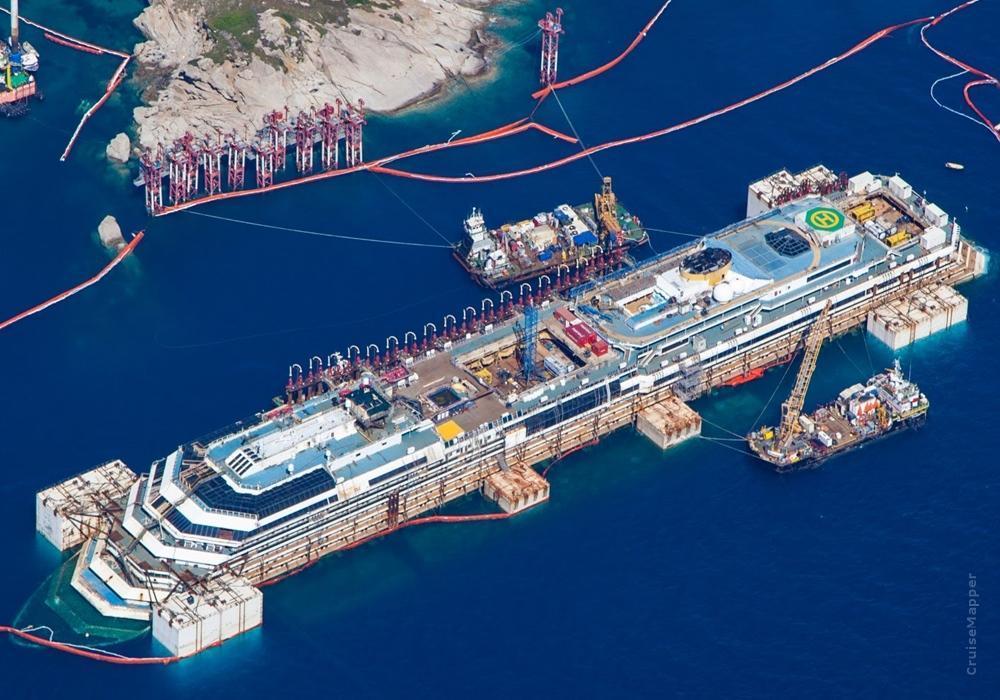
Seven leading marine salvage firms competed for the contract. The winning bid came from Titan Salvage (USA), partnered with Italian engineering company Micoperi. Procedures included sealing all hull breaches and creating airtight compartments, pumping air for buoyancy, then using cranes and pontoons to straighten and refloat the ship for towing to Genoa.
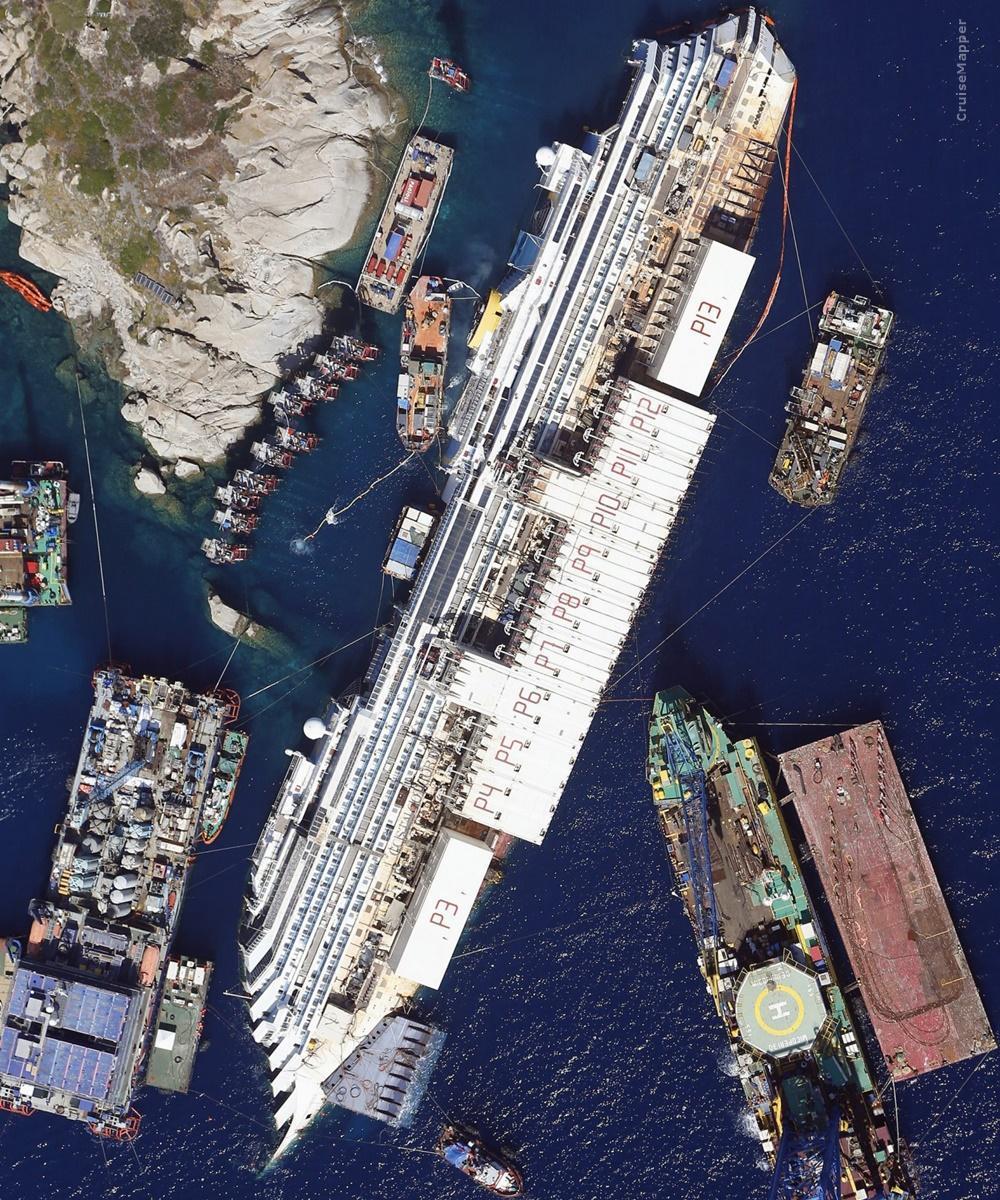
The estimated salvage cost was initially ~USD 300 million (EUR 225 million), but by September 2013, it had reached EUR 600 million (~USD 800 million).
Salvage Plan – Wreckage Removal Procedures
Concordia’s salvage plan was complex and included the following steps:
- Anchoring and Stabilization: Four submarine anchor blocks were fixed to the seabed, with 12 retaining turrets and 24 chains to hold the ship during parbuckling.
- Submarine Supports and Caissons: Eco-friendly grout bags were installed to stabilize the hull. Six platforms were anchored to the granite seabed, and 15 portside re-floating sponsons were welded onto the wreck.
- Parbuckling: Using hydraulic strand jacks, the ship was carefully rotated upright without deforming the hull.
- Starboard Caissons: Fifteen more sponsons were installed on the starboard side for the refloating process.
- Refloating: With the ship resting on the artificial seabed (~30 m deep), water was pumped from the caissons to raise the wreck. Even so, ~18 m remained submerged.
- Ecosystem Restoration: The seabed was cleaned, and marine flora replanted.
- Defueling and Caretaking: SMIT Salvage and Tito Neri led defueling with 100 international specialists and 20 vessels. Operations included oil removal, debris clearance, and safety monitoring by Titan and Micoperi teams.
Approximately 500 workers from 18 countries participated at the Giglio site, supported by ~30 marine vessels. Total costs exceeded USD 400 million.
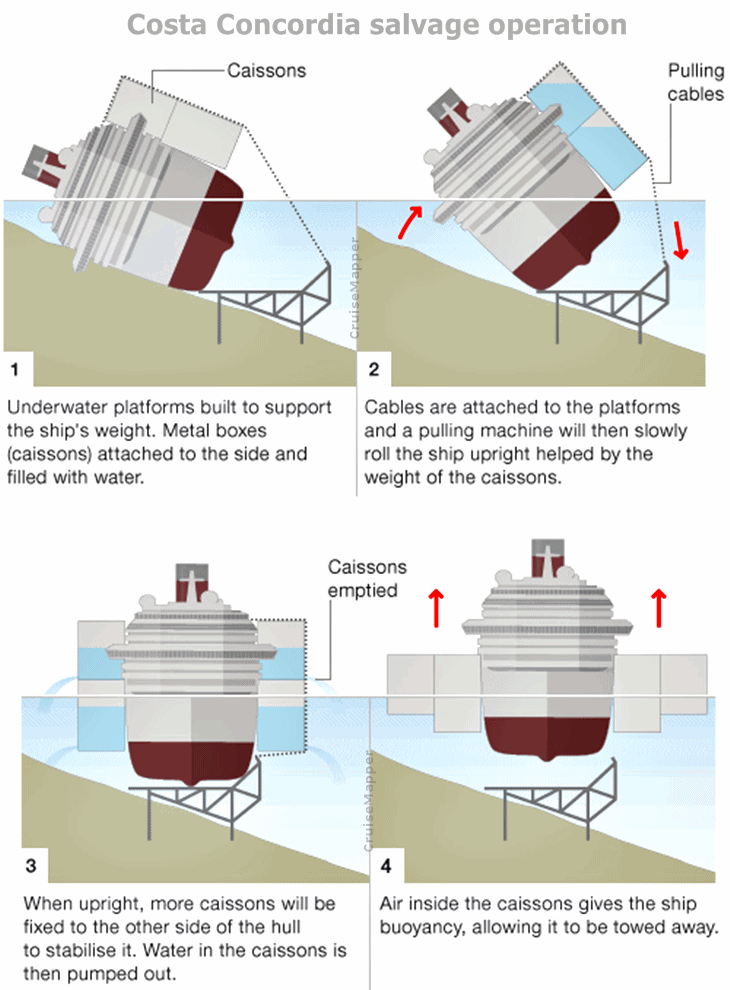 The following YouTube video (Nat Geo documentary) explains all details of the salvage procedures.
The following YouTube video (Nat Geo documentary) explains all details of the salvage procedures.
Salvage Operations Progress (2013)
- April 5: The largest underwater platform (Platform No. 1) was installed—~1000 tons, supported by 5 pillars, lowered into place by heavy-lift ship Svenja (SAL Heavy Lift).
- April 10: Costa accepted a fine of USD 1.31 million (EUR 1 million), settling all potential criminal charges. While some survivors accepted EUR 11,000 compensation, others pursued higher settlements through civil lawsuits.
- April 15: Hearings began to determine the trial of Captain Schettino and five officers.
- April 17: The first portside sponson (P10) was installed.
- June: A second ~1000-ton platform was installed—5th of the 6 designed for post-uprighting support.
- July 22: Titan-Micoperi and Costa Cruises presented a removal progress report.
- July 23: Five Costa officials and crew were sentenced to 18–34 months. Captain Schettino’s trial was postponed pending additional tests.
- September 17: Parbuckling was completed after a 20-hour operation that began September 16 using 22 hydraulic pumps.
- October 10: "Winterization" efforts began to stabilize the wreck for winter.
- December: Engineers confirmed the wreck would be removed by June 2014.
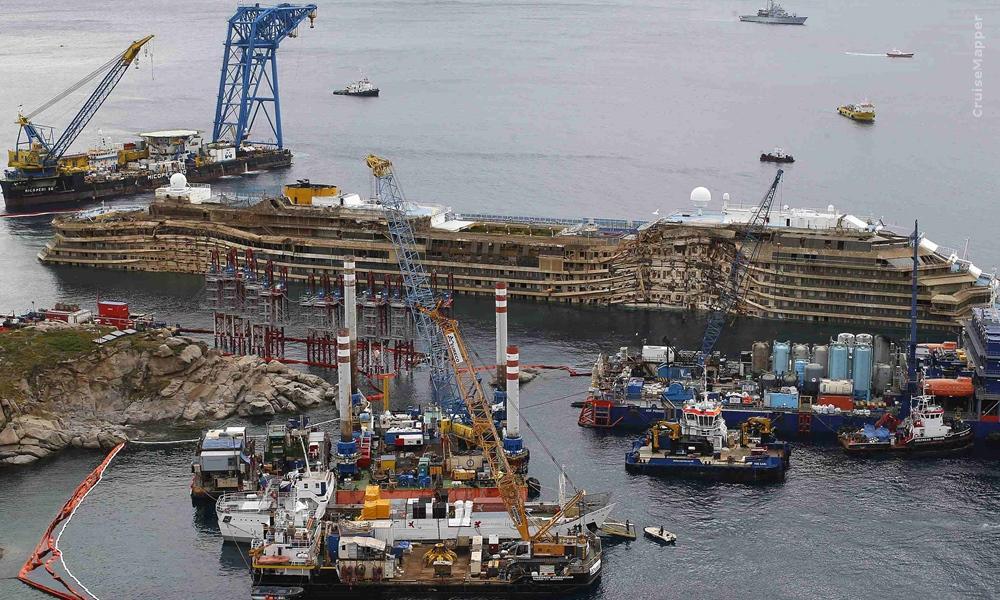
Alternative Wreckage Removal (Boskalis-Dockwise Vanguard)
Costa explored using Boskalis' semi-submersible lift ship BOKA Vanguard as an alternative to towing. Vanguard could carry up to 110,000 tons and was designed for transporting oil platforms and large vessels.
- DWT: 116,173 tons
- Length: 275 m (902 ft)
- Width: 79 m (259 ft)
- Power: 27 MW (36,208 HP)
- Speed (unloaded): 26 kph / 16 mph
- Speed (loaded): 24 kph / 15 mph
- Crew: 40
Removal process included submerging the Vanguard, positioning the wreck, then refloating it for transport.
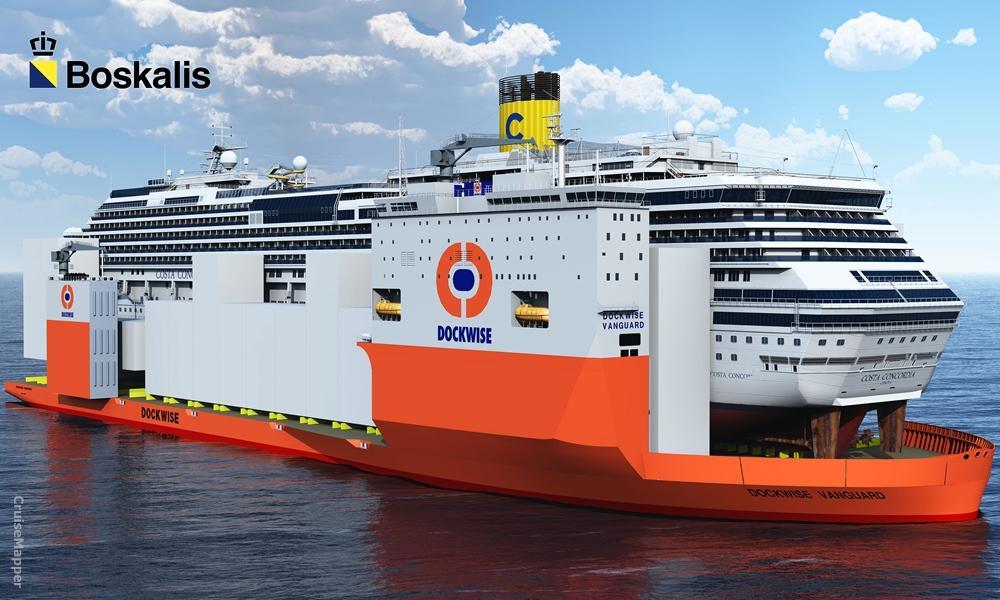
The Ship's Final Voyage (Tow to Genoa)
Towing began on July 22, 2014, ending in Genoa on July 27. The wreck was escorted by 14 vessels, led by the tug Blizzard. Two tugs towed from a 700-800 m distance at 2.5 knots (4.6 kph / 3 mph). Onboard were salvage engineers and Greenpeace environmentalists.
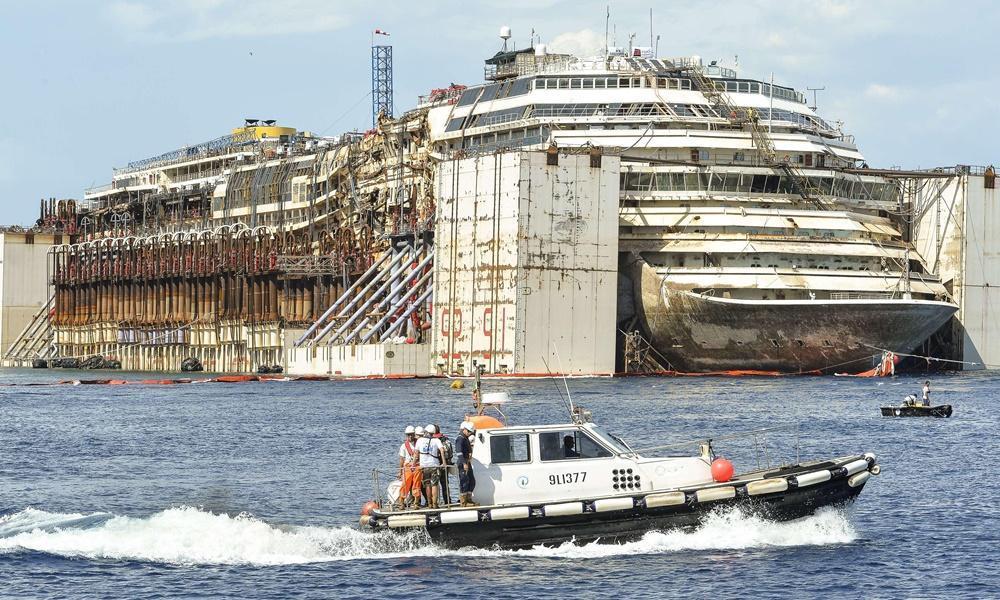
In Genoa, the ship was dismantled by the "Ship Recycling Consortium" (Saipem and San Giorgio del Porto Shipyard). Roughly 70% of materials were recycled and sold as scrap. The ownership transfer to Saipem was signed on July 27 at 3:40 pm.
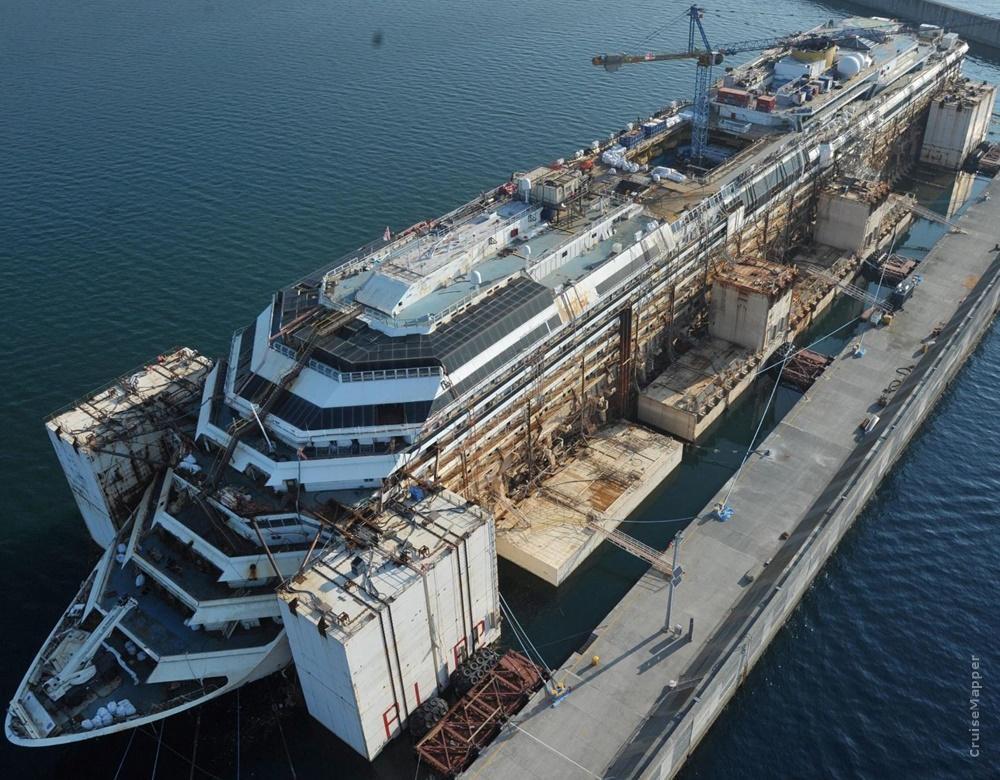
Concordia’s final journey was symbolic—one of the saddest cruise ship images ever. The three-year salvage operation became one of the most significant maritime recoveries. The dismantling was expected to take 22 months, under Italy’s Ministry of Environment supervision.
Was it really an accident, or a high-stakes financial play? Speculation ranges from stock manipulation to corporate opportunism. Regardless, Costa Concordia was a triple disaster—lives lost, reputational damage to the cruise industry, and vast amounts of money spent on recovery. It remains the worst cruise ship accident in modern history—caused, ultimately, by human error.
Costa Concordia ship related cruise news
- Cruise Industry
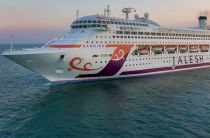
India’s cruise market expands with domestic growth and new entrants
India's cruise shipping industry is experiencing continued growth, attracting increased attention from multiple companies. While historically serving...
February 23, 2025 - Accidents
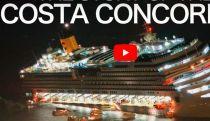
Costa Concordia Story
Costa Concordia sank on the evening of Friday, January 13, 2012, off the Tuscan West Coast of Italy near the island of Giglio. The ship's sinking was...
September 9, 2018 - Cruise Industry
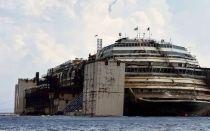
Costa Concordia Dismantled in Italy
The dismantling and recycling of Costa Concordia cruise ship has been finally completed in Italy and marked the official end to history's...
July 17, 2017 - Accidents
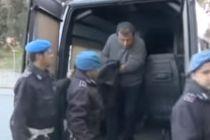
Captain of Shipwrecked Costa Concordia Goes to Jail
The Italian captain of Costa Concordia ship which crashed into a reef, killing 32 people in 2012, was headed to prison in Rome after losing the final...
May 13, 2017 - Accidents
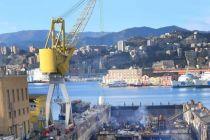
Costa Concordia Torn Apart 5 Years After Tragedy
The large-sized passenger ship Costa Concordia which capsized killing 32 people onboard is being torn apart 5 years after the tragedy. The luxury...
January 15, 2017 - Cruise Industry
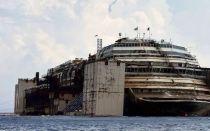
Abandoned Cruise Ship Becomes Stage for Haunting Photos
The Costa Concordia cruise ship was one of a kind. The luxurious vessel wowed just about everyone who stepped foot on it. This monstrosity...
October 21, 2016 - Accidents
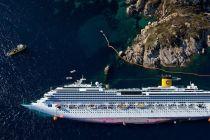
Costa Concordia Captain's Sentence Upheld
An Italian appeals court upheld the 16-year jail term handed to Francesco Schettino, captain of the sunken Costa Concordia. In 2012, the ship sank...
June 1, 2016 - show more news
Other Scrapped Cruise Ships cruise ships
Costa Concordia Wiki
The vessel (yard number 6122) was ordered by Carnival Corporation on January 19, 2004. It was launched on September 2, 2005, and delivered to Costa Cruises on June 30, 2006. The ship's godmother was Eva Herzigova (born in 1973), a luxury brand fashion model.
The "jinxed" cruise ship - facts and fiction
The disaster occurred on Friday the 13th in 2012. Some noted that RMS Titanic sank nearly 100 years earlier—on April 14, 1912.
The ship was named "Concordia". This brought to mind the Concorde plane crash on July 25, 2000, which killed 100 Peter Deilmann cruise passengers (booked on MS Deutschland) when their chartered Concorde aircraft crashed during takeoff in Paris, France.
During the christening ceremony on September 2, 2005, the ceremonial Champagne bottle failed to break on the ship’s bow—a traditional sign of bad luck.
On November 22, 2008, Costa Concordia collided with the pier while maneuvering for berthing in Port Palermo (Sicily), sustaining damage to her bow hull.
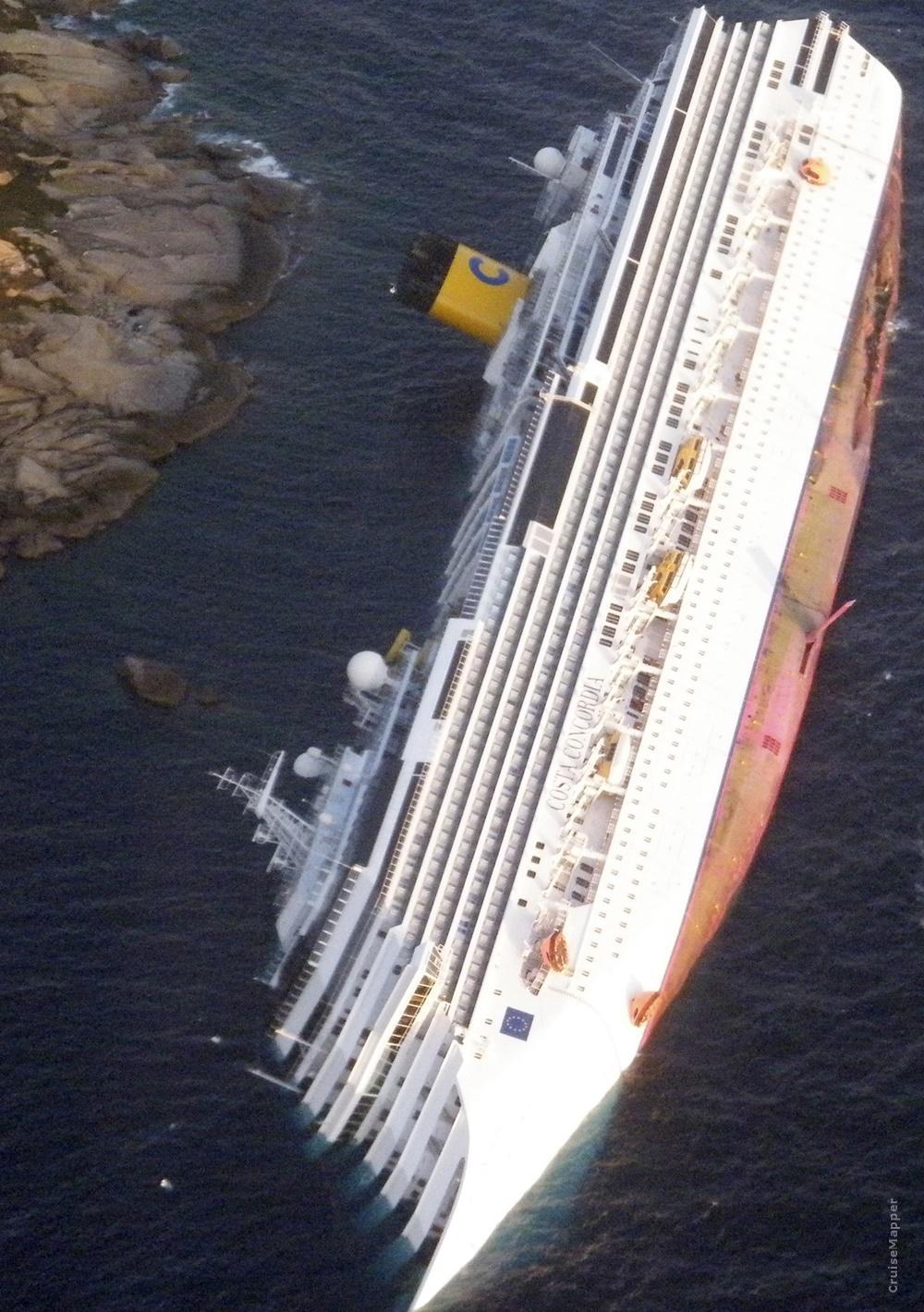
After the shipwreck, approximately 18,000 bottles of wine and 6,900 liters (~1,820 US gallons) of ice cream remained on board, along with other food and beverage provisions.
The financial disaster
As one of the most expensive large cruise ships (costing USD 570 million / approx. USD 149,000 per berth), Concordia also became the "largest insured loss in maritime history," being insured for USD 513 million (EUR 405 million). Her insurers included XL, RSA, Generali, and Allianz. Initial estimates placed insurance losses between USD 500 million and USD 1 billion.
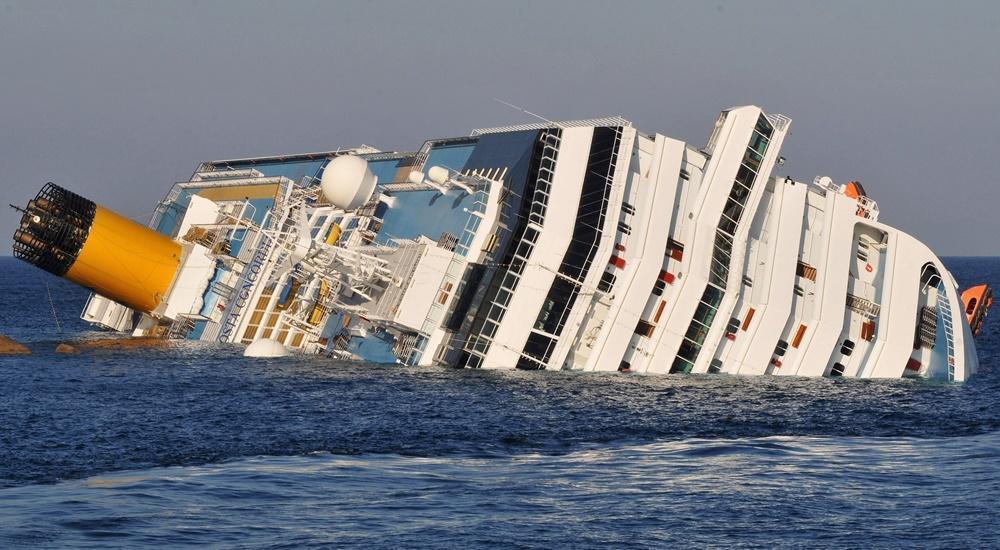
The situation could have worsened dramatically if more than 2,300 tons of diesel fuel had leaked, triggering a massive pollution liability claim. This risk alone caused Carnival’s stock to drop by 18% on the London Stock Exchange.
Carnival Corporation estimated the disaster would cost between USD 155-175 million (EUR 118-133 million), including insurance deductibles and loss of use. To maintain bookings, Carnival Cruise Lines (the Corporation’s largest brand by fleet capacity) lowered prices fleetwide, which further reduced FY2012 net revenue and earnings per share.
In 2015, Costa Crociere announced that the total cost of the wreck removal operation had reached EUR 1.5 billion (GBP 1.2 billion / USD 2 billion)—nearly the cost of building two Royal Caribbean Oasis-class ships (world’s largest passenger liners).
Costa Concordia and the Mafia
According to the UK's "The Independent" (reporting on Italian media "La Repubblica") in March 2015, Costa Concordia was allegedly carrying a "large shipment of Mafia-owned cocaine" at the time of the disaster.
This story, dubbed the "Concordia Mafia Drug" scandal, was based on taped conversations among Calabrian Mafia members. The Ndrangheta syndicate allegedly stowed large quantities of cocaine aboard the ship, likely with help from crew members, as part of its transatlantic drug trafficking operation.
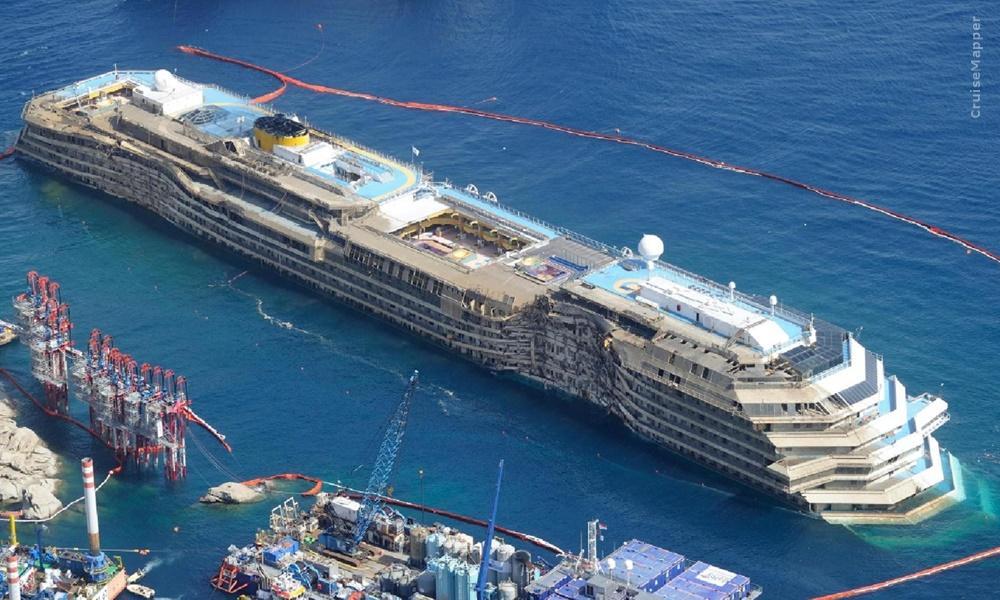
After the incident, Captain Schettino’s hair tested positive for cocaine. In March 2015, three crew members were arrested on Costa Pacifica upon disembarkation in Malaga (Spain) for possession of over 16 kg (35 pounds) of cocaine. This followed a Transatlantic repositioning cruise from South America. Investigations also revealed that other cruise lines, including MSC and NCL-Norwegian, were allegedly used by drug cartels for similar trafficking operations.
Concordia's Captain Francesco Schettino
Francesco Schettino, born in 1960 in Castellammare di Stabia (a coastal town south of Naples), was 52 years old at the time of the disaster. He joined Costa Crociere in 2002. Coming from a family of sailors, he trained at the naval academy in Piano di Sorrento, worked on tourist boats and superyachts, and was promoted to captain (second-in-command) in 2006. He commanded Costa Concordia for 5 years.
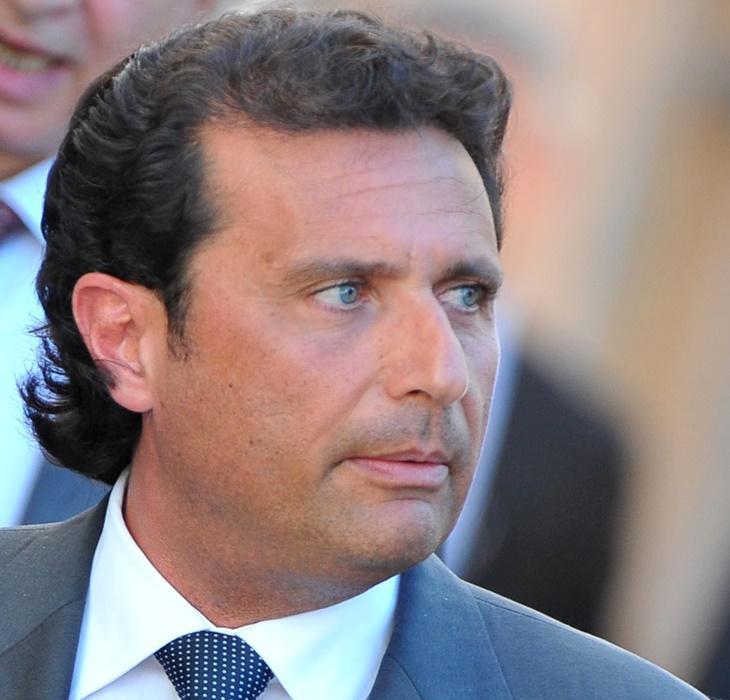
In 2012, he became one of the world’s most infamous cruise ship captains. Public opinion on his actions has been deeply divided:
- “He probably saved many lives.” Some defend Schettino, claiming that steering the ship toward port after the collision prevented greater loss of life. A Facebook support group with over 10,000 members—mostly sailors—expressed this view.
- “In danger, self-preservation is instinct.” This reflects the psychological “fight-or-flight” response. Though Schettino claimed he “tripped and fell into a lifeboat,” abandoning ship is widely considered unacceptable for a captain. Effective staff evaluation and emergency training are essential for cruise ship personnel.
- “A daredevil captain.” Known for his flamboyant image and risk-taking, Schettino reportedly left Port Marseilles in 60-knot winds against authority orders just a month prior to the accident.
- “Encouraged by superiors.” According to Schettino’s 135-page testimony, the sail-past near Giglio had been planned and approved. Similar “salutes” were reportedly common among Costa captains and used as publicity stunts.
Captain Schettino stood trial and was charged with manslaughter and abandonment. The final accident report attributed the disaster to “the Master’s unconventional behavior.”
On February 11, 2015, he was sentenced to 16 years in prison: 10 years for manslaughter, 5 years for shipwreck, and 1 year for abandoning ship. He was also ordered to pay court costs. On May 12, 2017, Italy’s Court of Cassation upheld the verdict and confirmed the sentence.
Schettino is married to Fabiola Russo, with whom he has a daughter. At the time of the collision, Domnica Cemortan, a Moldovan dancer and his alleged lover, was on the Navigation Bridge. She was neither a crew member nor a ticketed passenger.














